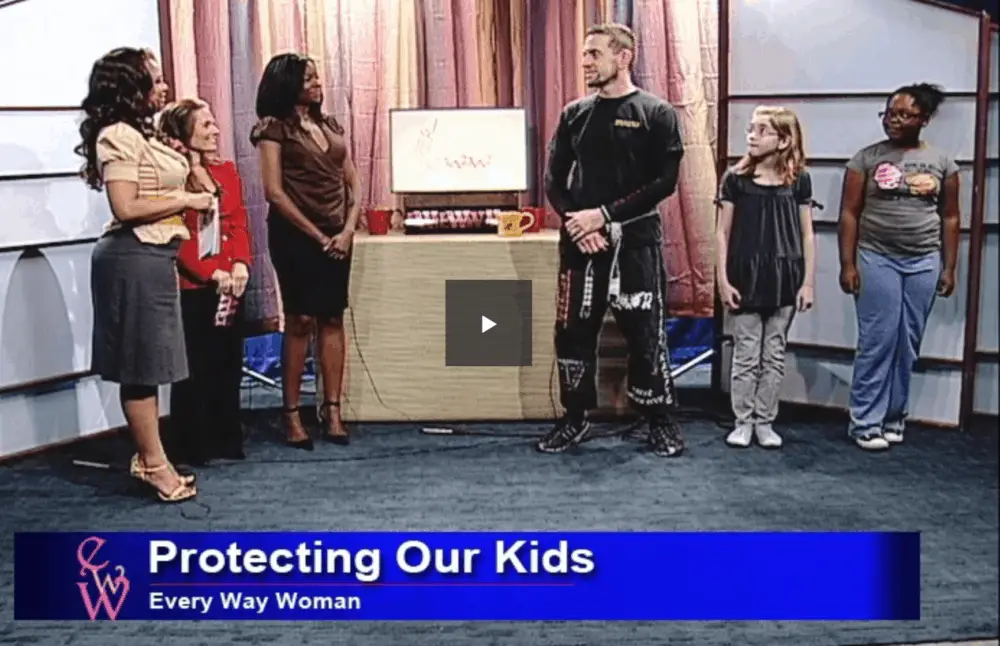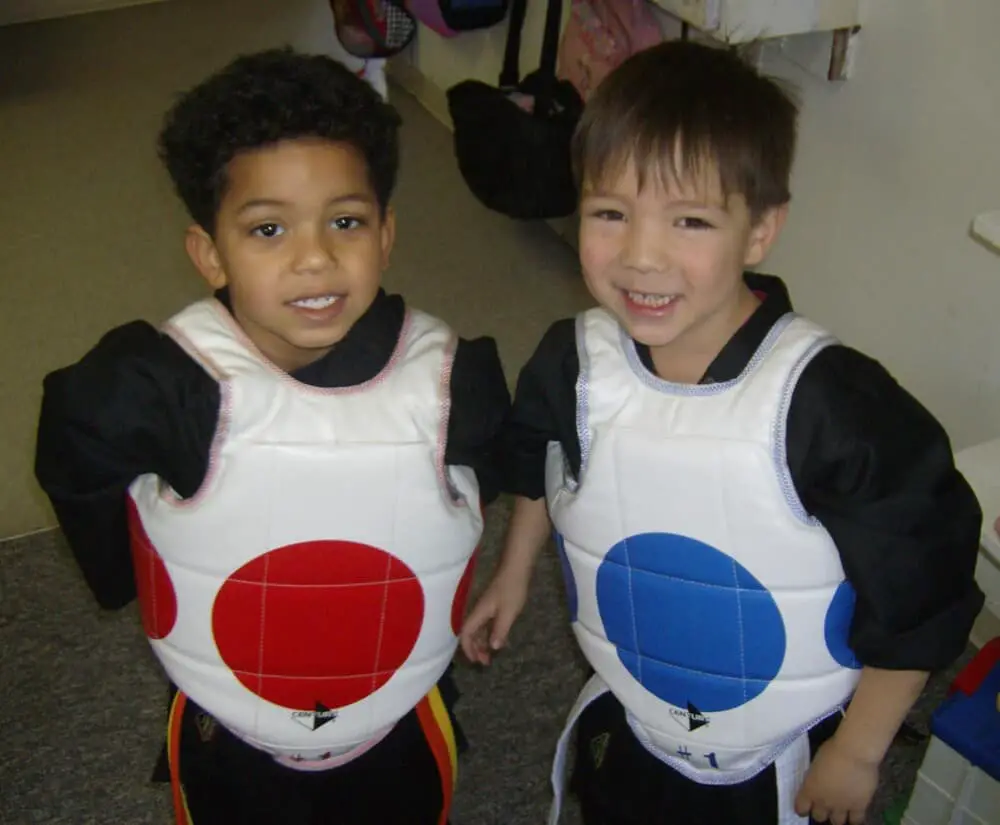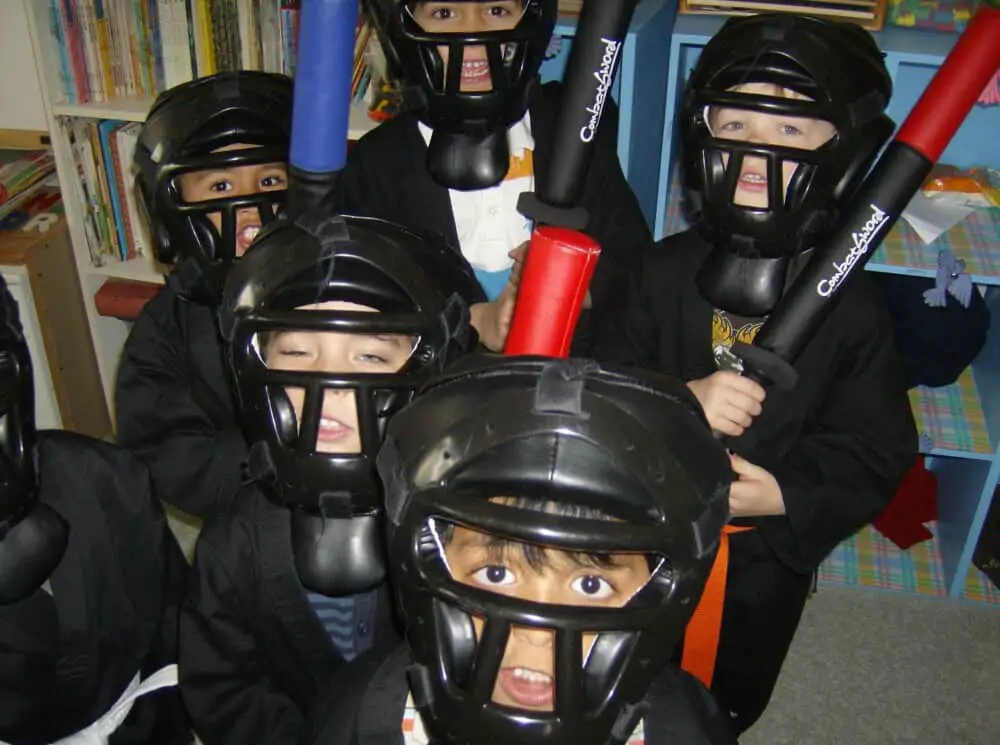
There is a lot going on in the world and a lot of uncertainty. While a parent tries to be there to take care of their child at all times there are going to be times when the parent is not around. Making sure your Little Ninjas know what to do in an emergency, bully situation, or if approached by a stranger gives you peace of mind for you.
Children need to learn how to defend themselves in any situation where a parent may not be present. Martial arts teaches self defense for kids in the areas of strangers, bully prevention, animal safety, and utilizing increased physical fitness to bolster ability and self confidence.
A good martial arts program will teach a child self-defense, discipline, and confidence. A child will develop the skills to defend themselves, the discipline to know when to use these skills, and the experience to know when to simply get away. Read on to find out what self defense means for kids and how a martial arts class may just be the answer.
Contents
- What is self defense for children?
- At What Age Should My Child Start Self Defense Training?
- Will Self Defense Training Teach my Kid to be Violent?
- Should I Teach My Child Or Find A Self Defense Instructor?
- What does self defense training look like?
- The Self Defense For Kids Takeaway…
What is self defense for children?
Martial arts teaches children various ways to defend themselves. It will also teach them about specific dangers and what they can do to stay safe. It is hard to find another program whether done through private organizations or public school systems that specifically address the dangers that kids face.
There are programs that attempt to address the issue, but most of them will only touch on one or two of the most important areas that kids need. Some will also only offer plans of action without actually training a child to perform any of the steps under stress.
Not to mention, many of these so called plans for children are developed by those with no experience in actual self defense or de-escalation situations.
There are key elements to a child’s self defense plan that need to be addressed by those that have performed many of the techniques they teach in the adrenal state. This can usually only be found in a quality martial arts instructor.
Self defense for kids really involves four main aspects.
- Stranger awareness
- Bully Prevention
- Animal safety
- Physical Fitness
There are other areas of safety for children, but many of those will be more in the realm of parents and teachers doing the protecting. Here we are concerned with what we can teach our kids in the event we cannot reach them in time.
In all four of these areas, there are several skills that children can use to help keep them from situations that can be harmful. Along with physical techniques and environmental awareness, knowledge is one of their most effective tools. Yet, this knowledge must be backed by practical application and training.
If you have a younger child that you would like to get started in a fun and useful self defense class that you can have them take right from your own home, then you should look into my online classes for preschool through elementary aged kids.
It is a no obligation fun survey of many styles of martial arts and you can get all the info here.
‘Stranger Awareness’ In Children’s Self Defense

In a study done by researchers in the Department of Psychology at Glasgow University, children were found to be underserved by ‘Stranger Danger’ programs in public schools and government programs. The purely descriptive exercise meant to develop only awareness as an all in one solution for children tended to be ineffective.
The children in the study instructed in those programs had trouble in many situations even identifying threats, not to mention responding appropriately.
There is also the sad fact that the vast majority of abuse comes from adults the child is familiar with. The ‘stranger’ driving by slowly in a car can happen, but is statistically unlikely. According to this study, only 115 children are abducted by strangers every year. That is only 1/100th of 1% of abductions each year.
The ‘strangers’ that abduct children usually come from the pool of people they know. Identifying strangers becomes irrelevant in these situations.
The main failing here lies in the fact that these programs were designed not by those with experience defending themselves and others, but by academics proposing what they believed ‘should’ work in similar situations and what the threats ‘could’ be.
Classes designed by quality martial arts instructors will go over stranger awareness in a much different way. They will talk to children about the dangers adults in general could pose, but the self defense training only begins there. There will be practical techniques and repeated training in getting away, finding help, and using environmental features to their advantage.
Things like never going anywhere with a stranger or to take anything from a stranger are good to teach children. But there also needs to be physical responses developed in a child for when situations go beyond simply identifying the threat or the threat comes from a familiar adult.
Martial arts self defense training will teach that a stranger should not be asking a child for help and if a child is approached by a stranger they should get out of the area immediately. It will also teach how to get out of the grasp of an abuser even if that person is a family freind.
A quality Karate, Judo, or other program will also drill and prepare in the event they cannot escape as well. Kids are armed with practical self defense techniques as well as knowledge.
Bully Prevention As Self Defense For Kids
One of the main problems with some forms of bully prevention programs is their insistence on a non-physical response. Then other programs seem to have an insistence on teaching kids with underdeveloped moral and reasoning abilities to beat another child into compliance.
There has to be a balance. A quality plan devised by a good martial arts instructor will combine verbal and physcial responses for real world bullying situations. There really is no substitute for a quality martial arts instructor teaching a tried and true system. Some of the better systems that teach practical self defense to kids are…
- Judo (excellent with takedowns and control)
- Karate (good combination of striking and grappling defense)
- Brazilian Jiu Jitsu (when modified for children, similar to Judo)
- Wrestling (excellent with takedowns and control)
- Taekwondo (great for distance control)
Unlike verbal only programs popular in public schools and advocated by some social scientists, our children simply aren’t surrounded by other children that will truly respond to those measures.
Without the confidence that if a confrontation becomes physical the child will be able to handle themselves, most any child will not have the fortitude to draw lines and confront threats.
In a quality martial arts bully prevention program, while children are told to find an adult or a teacher they are also taught that they may need to take immediate action. While the child should always report bullying to an adult there are some situations where they may need to be prepared to take physical precautions until help arrives.
There is one piece of equipment that every Judo or Jiu Jitsu kid will need. It is inexpensive and fun. With that combination, how can you go wrong. I recommend this throwing / grappling dummy that you can order on Amazon.
Knowledge About Animal Safety Keeps Kids From Harm
Animals of all types can either be a help or a threat to humans. Animals, even ‘domesticated’ ones are always a potential threat. When these humans are little and more vulnerable, the situation becomes one of safety and even defending those at risk.
Kids need animal awareness and avoidance tactics included in their self defense programs.
Here’s why…
It many surprise you to learn what types of animals are the most threatening to people. And it has much more to do with our proximity to them than viciousness or the perceived ability to harm.
Kids Self Defense Against Animals

According to a study done by researchers at the Wisconsin School of Medicine and using data from the CDC, the animals that tend to do the most harm, most of the time to children and adults are ones that are commonly in their routine environment.
Here is a list of some of the most dangerous animals to children and adults alike according to this study and others done by the Center for Disease Control.
| Type Of Animal | Environment | % Of Caused Yearly Deaths |
| Cows, Horses, & Livestock | Agricultural | 38% |
| Bees | All | 29% |
| Dogs | Homes (Family/Friends) | 15% |
| Insects | All | 8% |
| Snakes | Forests & Fields | 6% |
| Venomous Spiders | All | 3% |
| Crocodiles & Alligators | Near Water (Specific Regions) | 0.5% |
| Sharks | Oceans | 0.5% |
In terms of keeping kids safe and teaching them to defend themselves, simply controlling their environment is a key factor. For the majority of the deaths caused by animals each year, it could have been avoided by simply ‘not being there’.
Now, for adults I am not advocating boarding yourselves in your houses. These risks are something we have all accepted and managing them allows us to live full and happy lives.
Yet for children, who in the case of animal attacks are the most vulnerable, controlling their exposure to some of these groups can be the most effective method.
One thing you may readily notice though is that some of these environments are normal everyday spaces. Here is where it is important to develop strategies.
For those highly allergic to bee stings taking precautions, education on what to do, and even ‘bee kits’ may need to be in order.
For others like our next category, a much more dedicated approach should be not only taught, but regularly drilled. Many martial arts schools will do just that.
Kids Self Defense Specifically Against Dogs
There are some staggering numbers that have been put out be the Children’s Hospital of Pittsburg about dog attacks. This chart could be the eye opener that helps some parents take this form of self defense seriously.
Because of the proximity of children to these pets in their own homes or in the homes of family and friends the numbers are high. This is also taking into account not just deaths, but even attacks that can cause physical and emotional scars.
| Dog Attacks In U.S. | Time Frame | # Child Victims |
| 4,700,000 total | each year | 2,350,000 |
| 12,877 total | each day | 6438 |
| 537 total | each hour | 268 |
| 9 total | each minute | 5 |
| 800,000 requiring hospital treatment | each year | 400,000 |
| 2600 requiring hospital treatment | each day | 1300 |
| 100 requiring hospital treatment | each hour | 50 |
| 2 requiring hospital treatment | each minute | 1 |
According to the CDC, dog attacks are more of a threat to children than some of the more serious diseases that we try to protect them from. This includes the combined numbers from:
- measles
- mumps
- whooping cough
How should we handle this? A good martial arts program that takes seriously their mandate to help children protect themselves in all situations will have some form of dog and animal safety program.
I definitely do this in my classes. I was attacked by a dog at the house of a family friend when I was a toddler. I still have a scar to show for it many (many) decades later.
Some of the elements that should be addressed and drilled with physical, verbal, and mental responses are:
- Who should children ask before petting dogs?
- What to do if a dog starts barking
- How to respond if a dog begins to chase
- Children should keep distance while dogs are eating
- Children should not openly smile baring teeth at strange dogs
There are many more to this list. Check with your child’s instructor or prospective instructor. You most definitely should research and go over these types of things with your child yourself.
But when it is coming from a Karate instructor wearing a black belt and chasing them on all fours while barking, it tends to stick.
Falling – Defense Against The Thing That Injures Most
I tell this story often to kids and parents. I do it because it is slightly surprising, but more importantly because it illustrates a truth that will help your child from today until their last days.
After Judo practice one day a couple of training partners and I were talking and joking when we noticed our instructor speaking with a man in a Judo Gi that had to be in his late seventies. This caught our attention.
He wore a black belt and our instructor introduced him as an over 50 year black belt in Judo. Each one of us had several questions after showing the proper respect. The issue all the questions revolved around was the same: “Sensei, what has been your most useful technique of all?”
We all expected to hear the Japanese name of some throw, strangle hold, or even some secret variation of a pinning technique. Nope. His answer was one word.
Falling.
Our shock must have been easily visible on all of our faces. He continued explaining that he had hardly ever in all his years had to defend himself against another person, but he had fallen so many times he couldn’t remember the number.
There really is only one main choice when you are wanting your child to learn this very important set of techniques. Judo.
Now, wrestling has its own version of falling and Brazilian Jiu Jitsu came from Judo so it retains many of the Ukemi or falling techniques. There is also the fact that many styles like Karate and HapKiDo have adopted the Ukemi Waza of Judo into their systems.
This is all to say, teaching kids to fall properly should be part of every self defense program of our Little Ninjas. Falling techniques just may be one of the most useful parts of self defense for kids.
Physical Fitness Increases A Child’s Confidence
One of the most important things that a child will learn is to have confidence. Following the same line of thought, physical fitness is one of the major factors that contribute to a good self image.
This is yet another aspect that will be dealt with in varying degrees by most martial arts programs.
They will learn how to be a strong person and rely on their skills and abilities. If a child is confident they are less likely to become a victim. Confidence can carry a child far and will give them the skills they need in life.
There are some basic fitness techniques that a child will learn in all styles, but research the different ones to see which will fit your child’s interests and body type.
With the ongoing obesity problem in the United States, it is never too early to learn about fitness and becoming physically active.
At What Age Should My Child Start Self Defense Training?

There is no right or wrong age to start a child off with martial arts and self defense training. There are classes for every skill level and every age.
It is recommended the early a child starts the better. A child as young as 2 years old can start with self defense classes. They will learn some basic techniques for self defense and they will learn why bullying is wrong in age-appropriate terms.
There are classes for a student of all ages so they can join at any time. If you would like to read more about what ages kids can start training and learning self defense, read my article hear about 2 year olds in Karate.
Will Self Defense Training Teach my Kid to be Violent?
Self defense training will not teach a child to be violent. It will teach a child the opposite.
According to The Journal of Applied Developmental Psychology, teaching self-defense through martial arts can increase children’s ability to self-regulate. This means children learn how to control their impulsivity and reactionary behaviors, making them more prone to peaceful responses rather than violence.
Avoiding Violence
A child will learn how to avoid violence. They will learn that violence is a last resort and there are other options they should take first. It is important not to take a physical response completely off the table, but it should be a rare case in which a child will need it.
They will stand up for themselves and will not be silent victims. Self defense training will help a parent have peace of mind.
They can rest knowing that their child will be able to defend themselves if they are threatened. They will also know that their child is learning the skills to become a well-round and respectful person.
They should learn how to talk and they will learn why they should not be bullies or support bullying. They will learn that violence is not the answer but they will be prepared to defend themselves if another person were to get violent with them.
Using Words is Mightier Than the Fist
All of us know of Dr. Martin Luther King, Jr. and his powerful speeches. At no time did he use his fists to demonstrate his point. Instead, King knew that with the right words and attitude, he was able to provide his message peacefully and still move mountains and hearts!
It is good that a child knows how to physically defend themselves but this should not be the first option. When they are disagreeing with someone forcing them to should never even be a consideration.
Martial arts will teach about other techniques to de-escalate a situation without things having to get violent.
Martial arts and self defense will look at the power of words. They will teach ways that conflicts can be resolved by talking about things. A person should always try to talk about things first unless they are in immediate danger.
The power of words may put an end to the situation before it can escalate. Words should be the first option for solving a problem. Physical actions are secondary. The child will learn that they should not strike first, but they should be prepared to defend themselves if someone tries to harm them.
At that time they can go into self defense mode and take the actions that they need to do to stay safe. In most cases words and the willingness to work out a situation will be more effective than using the fist of other forms of physical aggression.
I also recommend Anger Management Workbook for Kids. With almost 5,000 reviews and 4.6 out of 5 star rating on Amazon, it’s become a go-to support!
Use Groups to Stay Safe
It is important to remember that there is power in numbers. A group of kids is more than likely to be left alone than a single child walking by themselves. This can be true for adults too. A group is much less likely to be bothered than an individual.
Avoiding violence is not only abstaining from that choice yourself. It also involves not making your self an easy target for those that may not have the same discipline or impulse control.
Children should avoid walking or going anywhere alone when possible. They should stick to a group. Bullies are less likely to confront a group.
They will not be able to take on all of the members and they will not want someone from the group to put them in their place. Bullies look for easy targets and will simply change their mind when they can’t find one.
The same can be true for strangers. A stranger is less likely to start trouble with a group. They target lone children.
When possible stay with others and be part of a group. Children should be together especially if there is not adult for immediate supervision. This is even true for teenagers and other adults. They are safer when they are not alone.
Should I Teach My Child Or Find A Self Defense Instructor?

When it comes to the self defense and when to use these moves you should leave the teaching to a quality instructor. They will make sure to teach the child it is not okay to be the aggressor.
Some parents will be able to do just fine. But in the same way we wouldn’t take our car to be fixed by a plumber, it makes sense to find someone who is a professional in the right field. This also means they should be highly experienced teaching kids.
Your Little Ninjas will learn how to do these moves correctly and learn how not to get hurt when doing so. Instructors will also know how to train your child to actually be able to use the techniques in a high adrenal state.
You should still talk to your child about the danger of strangers and to tell an adult. You should also tell your child about bullying and the reasons why they should not be a bully.
If you have an older child or even a teenager they will benefit from onsite training at a dojo. They will learn about respect from the instructor and will learn everything in a hands on way needed to properly defend themselves.
If you have younger children you can enroll them in online classes. These classes will help keep them learn the basics at their own pace and in an environment that is comfortable.
They will also get the skills from the instructor that though parents may know, will be more interesting coming from a guy in pajamas and wearing a black belt.
What does self defense training look like?

A good child’s instructor will employ drills, games, and fun competitions with other kids and even with the self in order to help children fully engage the instruction. It is much more likely that a child will learn when the subject and deliver is fun.
Physical Fitness In Kids Self Defense Training
Getting into shape helps with health, confidence, and even overall happiness. It is also essential for performing well in most martial arts systems.
Many types of bodyweight exercises are used in self defense classes for kids. Many times they will be turned into drills, games, or even races. It is all to ‘trick’ the kids into doing much more than they otherwise would have.
Grappling In Kids Self Defense Training
There are many different ways that a person can learn to defend themselves. Some techniques are designed for children to help them stay safe.
One of the biggest things that a student will learn is how to grapple. It entails takedowns, hold-downs, and escaping techniques. This wrestling component is more or less prevalent depending on the style.
Striking In Kids Self Defense Training
They will also learn about striking. While martial arts and self defense training state that the student should not attack first, they need to be able to strike at times.
The striking will be effective and appropriate to their age level. Sometimes it will be designed to keep distance from an attacker, convince them to stop, or to get away from the threat.
This is usually trained on pads, targets, and kicking bags. These are even very useful pieces of equipment that you can use in your home. I have an article here that is very popular on the best kicking bag for all styles and all ages.
Weapons In Kids Self Defense Training
Weapons may be used or threatened to be used against the student. This self defense class will teach a child what to do when they are threatened and there is a weapon involved.
They will learn several techniques to stay safe and they will even learn if it is the right time to disarm the attacker.
Another main use of this type of training is to develop hand eye coordination in a fun and safe way. One of my most popular sections of a kids class is when we do Kali martial arts training.
All of the defense training is taught not to scare the child. The lessons and techniques will be talked about and taught in an age appropriate way.
While this is serious information to learn, all of the training is designed to be fun so that the child will want to participate. There will be different methods used to keep the attention of the child and to allow them to engage in the lesson.
Martial Sports In Kids Self Defense

When some people hear about martial arts they may think of the competitions, trophies and medals. Images of matches where a person has to take down their opponent may come to mind or jumping and kicking chest pads be what they think of.
There is more to the sport side of training than this. Martial art is a teaching of self respect and defense. One way to learn this is through defeat and losing. They develop character through picking themselves up and continuing on anywy.
These competitions will show that they have learned to strike or grapple in a controlled way, but this is all to have them experince what their bodies will do in the adrenal state. When we are in the midst of stress, we tend to react very differently than we may have thought.
Martial arts is seen as a sport by many people and sadly even some instructors. Sport is a great way to get through to kids. Sport can even keep the attention of the most distracted child.
A child will do something they enjoy and they will learn how to stand up for themselves if they have trained it over in over in a the fun environment that sport provides. Sports is a great way to sneak in some life lessons as well.
Once again martial arts is not the total solution to self defense. A parent will still need to play an active role in going over topics including bullying and the danger of strangers. Yet, sport is a great motivator. It can be an effective tool in any parent or instructor’s toolbox.
The Self Defense For Kids Takeaway…

In the modern times, a child needs to know how to protect themselves. They are going to need to know how to stay safe.
If someone is starting trouble they need the skills necessary to get away, get help, and if necessary to protect themselves until they can. Stopping threats is really the goal, not conquering someone else.
When a child is going through self defense training they are learning how to be confident. They will learn how to take pride in themselves and their abilities. Confident children do better in school and have improved peer relations.
As an added benefit of self defense training, a child will learn about fitness. They will be working out and they will learn the importance of staying in shape and being physically active.
If you would like to get a Little Ninja started in online classes, take a look at my page here with all the details about my Online Karate Dojo.
References:
“Advantages of Self Defense for Kids Training Program.” SelfGrowth.com
